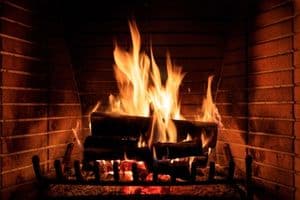To you, few scents in this world are better than burning wood. From a fireplace in your living room to a fire pit in the yard, the smell is so pleasant. A friend recently told you that burning wood produces carbon monoxide, which has you rethinking using that fireplace. Is it true?

The burning of wood leads to emissions of carbon monoxide amongst other things. The other potentially dangerous emissions include nitrogen oxide, sulfur oxide, and carbon dioxide. If you have a fireplace, triple-check that it vents outside.
In today’s article, we’ll answer all your most burning questions about using a wood fireplace, stove, or fire pit, including more information about the emissions released and how to stay safe. You won’t want to miss it, so keep reading!
Table of Contents
Will Burning Wood Produce Carbon Monoxide?
Burning wood is an incredibly common facet of everyday life. Forest Atlas through the United States Department of Agriculture estimates that in the United States alone, people burn between 10 and 15 billion cubic feet of wood every year.
Each time you do, you activate a combustion process. The reaction causes emission and heat to release through particulates, gases, organic vapors, and water.
Also, if you’re interested, check out this article about how hot a wood fire can get.
Not every emission that comes out of burning wood is dangerous, but enough are. They include carbon monoxide, nitrogen oxides, sulfur oxides, and carbon dioxide.
Let’s take a closer look at each gas now.
Carbon Monoxide
Carbon monoxide is released when fuels cannot completely combust. The molecules in carbon monoxide will displace what oxygen remains in a person’s body, which is how carbon monoxide poisoning occurs.
Nitrogen Oxide
Nitrogen oxide is usually produced through industrial processes but is released as an emission when burning wood as well. Depending on the extent and severity of exposure, nitrogen oxide could lead to asthma, respiratory infections, and chronic lung disease.
Suflur Oxide
Oxygen and sulfur molecule compounds are known as sulfur oxide. Although sulfur dioxide is the better-known version, sulfur dioxide is more dangerous. It has no color, but you can smell it and taste it.
Carbon Dioxide
Exhaling may release carbon dioxide, but the gas can still be risky for human health in large enough quantities. You can experience symptoms like convulsions, high blood pressure, high heart rate, tiredness, sweating, breathing troubles, pins and needles, coma, and even asphyxia.
The Health Risks of Carbon Monoxide
Carbon monoxide, like several of the gases above, produces no color. You can’t taste it, nor can you smell it, unlike sulfur dioxide.
That’s why carbon monoxide is referred to as the silent killer, as a killer it is indeed.
According to the Centers for Disease Control and Prevention or CDC, carbon monoxide sends 50,000 Americans to the emergency room every year and kills another 430 people.
No products found.
As mentioned, when you inhale carbon monoxide, it displaces the oxygen in your system. The gas also attaches to your hemoglobin, which is a metalloprotein in red blood cells that contains iron.
When that happens, your blood can’t transport oxygen to the rest of your body. You may experience symptoms such as wooziness, confusion, headaches, and fatigue as your brain’s oxygen supply cuts off.
Other symptoms that can accompany the above are vomiting, collapse, and confusion.
If you continue to stay in proximity to the gas–which you cannot tell if you are without a carbon monoxide detector–you can die quickly, usually within a matter of minutes. You’ll fall unconscious and then suffocate.
Fireplace and Fire Pit Safety Tips
Reading the last two sections has made you very scared to light a fire larger than a candle in your home. After all, burning wood will release carbon monoxide as well as a deadly cocktail of other gases.
While it’s always good to exercise a degree of caution, you don’t have to forego using your fireplace or a fire pit. Here are some safety tips to prioritize the heath of you and your family.
Keep Fire Pits Outdoors
Although we’re sure that most people know to use a fire pit outdoors, we wanted to make it perfectly clear that indoor use is terribly dangerous.
You’re releasing all those emissions, many of which can be life-threatening. Additionally, you’re also putting your home and your family at risk of fire if a flame from the fire pit catches on something flammable nearby.
Don’t Use a Wood-Burning Stove Indoors
Wood-burning stoves are quaint and old-timey, but they too are not designed for indoor use. You need to keep the wood-burning stove outdoors so all the emissions released can disperse into the air rather than enter your lungs.
Buy a Carbon Monoxide Detector
Carbon monoxide detectors save lives. If you don’t already own one, then do yourself and your family a favor and rectify that immediately.
Check the batteries in your carbon monoxide alarm every six months to confirm they’re working. Replace the batteries when their charge starts to get low.
Open Your Fireplace Dampers Before Using the Fireplace
Chimney dampers send air from the flue when they’re open. You should keep them closed when the fireplace is not in use to prevent the HVAC-cooled or heated air from needlessly exiting your house.
That said, ahead of running your fireplace, always open the dampers to give that carbon monoxide and other emissions a place to exit.
A wood-burning stove produces carbon monoxide, a dangerous gas with no color, smell, or taste. Breathing in carbon monoxide can be deadly.
You can still use a fireplace or a wood-burning stove, but only as intended. Be sure to buy a carbon monoxide detector and keep its batteries fresh as well. Stay safe out there!